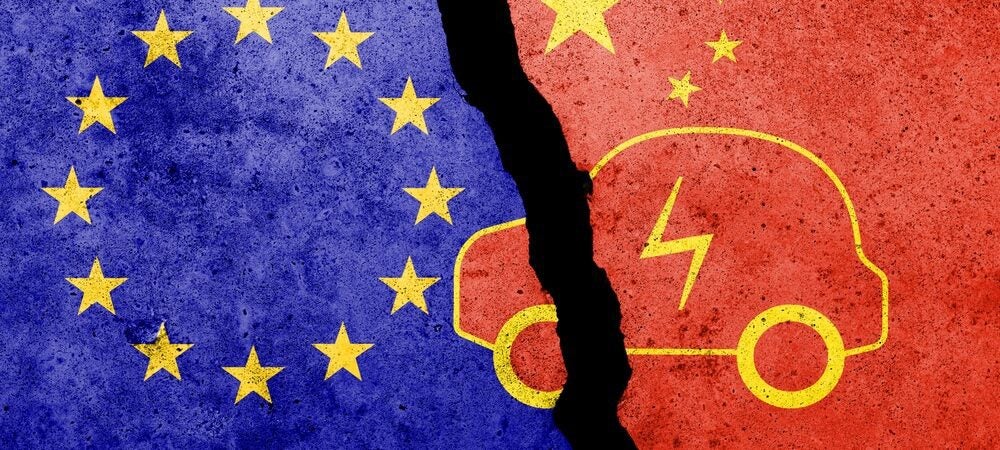On 12 June, following an anti-subsidy investigation, the European Commission disclosed that it would provisionally impose import tariffs ranging from 27.4 to 48.1 per cent on electric vehicles (EVs) from China. This comes a month after the United States announced that their own tariffs on Chinese EVs would rise to an unprecedented 102.5 per cent.
The Commission’s actions on EVs may not be the last taken against clean technology from China, with trade measures having recently been considered for two more major pillars of Europe’s energy transition.
An anti-subsidy probe into Chinese solar panel manufacturers bidding for a public project in Romania was closed after the targeted companies withdrew from the process.
An investigation into Chinese wind turbine suppliers is ongoing. Both were launched under the new Foreign Subsidies Regulation.
The risks of tariffs on decarbonization technologies
The EU is anxious to protect its companies from what it sees as unfair competition. It has bitter memories of the early 2010s, when cheap Chinese panels all but destroyed the European solar industry.
The EU is right to identify clean technology as a crucial strategic industry, and to take action to mitigate the negative consequences of surging imports from China. Against a volatile geopolitical backdrop, it can be worth paying a premium for goods made at home.
But decarbonization technologies like solar panels, wind turbines and electric vehicles share a characteristic that sets them apart from other traded goods. When swapped for fossil fuel alternatives, they reduce the quantity of planet-warming gases being pumped into the atmosphere. They are needed in vast quantities, and in very short order, to give any chance of avoiding the worst impacts of climate change.
The EU has a legally binding target of net zero greenhouse gas emissions by 2050, and an intermediate target of at least a 55 per cent reduction by 2030, relative to 1990 levels. A target of 90 per cent has been proposed for 2040.
These targets are ambitious, even if they are insufficient to limit warming to 1.5°C. With 2022 marking a reduction of 32.5 per cent, accelerated and sustained action will be needed. This implies deploying mass-market clean technology products like solar panels and electric vehicles in very large numbers.
The costs of European manufacture
The EU wants these to be manufactured within its borders. In her 2023 State of the Union address, Commission President Ursula von der Leyen was unequivocal: the EU’s clean tech future should be made in Europe.
The Green Deal Industrial Plan, announced in early 2023, seeks to do this by cutting red tape, increasing access to finance, boosting skills, and promoting fair trade. The Net Zero Industry Act sets a target for the EU to manufacture at least 40 per cent of the so-called strategic net zero technologies it deploys each year, by 2030.
The Act proposes to achieve this through measures including requiring public authorities to consider non-price ‘sustainability and resilience’ criteria when procuring renewable energy. This would in theory increase the attractiveness of goods made on European soil.
However, this requirement can be disregarded if it implies ‘disproportionate’ additional costs. It is therefore doubtful it will be enough to offset the large difference in production costs between Chinese- and EU-made solar panels, for example.
Building the factories needed to hit the Act’s manufacturing targets for solar panels and batteries is estimated to require nearly $70 billion by 2030.
But unlike in the United States, where the Inflation Reduction Act offers lavish subsidies, the EU’s Green Deal Industrial Plan provides little in the way of new finance.
The Plan loosens state aid rules, enabling member states to subsidize green industry, and proposed a new EU-level fund for investing in strategic clean technology projects.
However, the return of EU-wide fiscal rules will restrict government spending, including on the transition; the European Sovereignty Fund was scaled back and ultimately became a platform to mobilize private finance.
Current levels of investment in the EU’s transition fall far short, with the annual climate investment deficit estimated at €406 billion, or 2.6 per cent of GDP – implying that climate finance will need to roughly double to meet 2030 targets.
A June 2023 report by the European Court of Auditors found ‘no information that sufficient financing will be made available to reach the 2030 targets’. Climate-focused public spending is also likely to get squeezed by an increasing focus on security and defence.
With financial resources constrained, and the timeframe tight, the unit cost of each product needed to achieve the transition becomes an extremely important variable.
And when it comes to cheap, clean technology, China is the undisputed world leader. Two decades of consistent and targeted industrial policy, combined with the benefits of a huge domestic market, mean that China today produces extremely competitively priced, high-quality, low-carbon goods.
In 2023, solar modules in China were being manufactured at a cost of $0.15 per watt, compared to $0.30 in Europe. In France in 2023, the cheapest electric vehicles were priced between €22,000 and €30,000 ($24,000 – $32,500) while in China, over 50 electric models were retailing locally for less than CNY 100,000 ($15,000). Analysis by think tank Transport & Environment found that European automakers have prioritized large, premium electric vehicles at the expense of compact, affordable models.
All else being equal, anything which stems the flow of the cheapest low carbon products will increase the cost of the transition and slow it down, increasing the risk of the EU missing its emissions reduction targets.
These are not the only risks, however. If solar panels and wind turbines become more expensive, it will ultimately feed through into higher electricity prices, increasing the cost of living for citizens and exerting a downward pull on the fragile competitiveness of European industry.
To read the full expert comment as it was published by Chatham House, click here.

